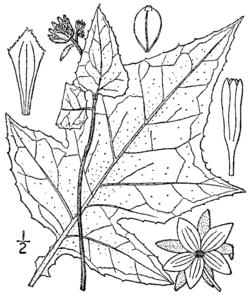| Polymnia canadensis | |
|---|---|
 | |
| 1913 illustration [1] | |
| Scientific classification | |
| Kingdom: | Plantae |
| Clade: | Tracheophytes |
| Clade: | Angiosperms |
| Clade: | Eudicots |
| Clade: | Asterids |
| Order: | Asterales |
| Family: | Asteraceae |
| Genus: | Polymnia |
| Species: | P. canadensis |
| Binomial name | |
| Polymnia canadensis L. 1753 | |
| Synonyms [2] | |
| |
Polymnia canadensis, commonly known as whiteflower leafcup, is a flowering perennial plant in the family Asteraceae. It is native to eastern North America from Ontario south to Alabama and from Kansas, Oklahoma, and Minnesota east to North Carolina, Vermont and Connecticut. [3] It is considered endangered in the last two states. [4] It is typically found in moist forests over calcareous rocks. [5]


